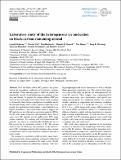| dc.contributor.author | Wolf, Martin Johann | |
| dc.contributor.author | Cziczo, Daniel J. | |
| dc.date.accessioned | 2020-04-13T19:03:50Z | |
| dc.date.available | 2020-04-13T19:03:50Z | |
| dc.date.issued | 2019-10 | |
| dc.date.submitted | 2018-09 | |
| dc.identifier.issn | 1680-7324 | |
| dc.identifier.issn | 1680-7316 | |
| dc.identifier.uri | https://hdl.handle.net/1721.1/124603 | |
| dc.description.abstract | Soot and black carbon (BC) particles are generated in the incomplete combustion of fossil fuels, biomass, and biofuels. These airborne particles affect air quality, human health, aerosol-cloud interactions, precipitation formation, and climate. At present, the climate effects of BC particles are not well understood. Their role in cloud formation is obscured by their chemical and physical variability and by the internal mixing states of these particles with other compounds. Ice nucleation in field studies is often difficult to interpret. Nonetheless, most field studies seem to suggest that BC particles are not efficient ice-nucleating particles (INPs). On the other hand, laboratory measurements show that in some cases, BC particles can be highly active INPs under certain conditions. By working with well-characterized BC particles, our aim is to systematically establish the factors that govern the ice nucleation activity of BC. The current study focuses on laboratory measurements of the effectiveness of BC-containing aerosol in the formation of ice crystals in temperature and ice supersaturation conditions relevant to cirrus clouds. We examine ice nucleation on BC particles under watersubsaturated cirrus cloud conditions, commonly understood as deposition-mode ice nucleation. We study a series of wellcharacterized commercial carbon black particles with varying morphologies and surface chemistries as well as ethylene flame-generated combustion soot. The carbon black particles used in this study are proxies for atmospherically relevant BC aerosols. These samples were characterized by electron microscopy, mass spectrometry, and optical scattering measurements. Ice nucleation activity was systematically examined in temperature and saturation conditions in the ranges of 217 ≤ T ≤ 235 K and 1:0 ≤ Sice ≤ 1:5 and 0:59 ≤ Swater ≤ 0:98, respectively, using a SPectrometer for Ice Nuclei (SPIN) instrument, which is a continuous-flow diffusion chamber coupled with instrumentation to measure light scattering and polarization. To study the effect of coatings on INPs, the BC-containing particles were coated with organic acids found in the atmosphere, namely stearic acid, cis-pinonic acid, and oxalic acid. The results show significant variations in ice nucleation activity as a function of size, morphology, and surface chemistry of the BC particles. The measured ice nucleation activity dependencies on temperature, supersaturation conditions, and the physicochemical properties of the BC particles are consistent with an ice nucleation mechanism of pore condensation followed by freezing. Coatings and surface oxidation modify the initial formation efficiency of pristine ice crystals on BC-containing aerosol. Depending on the BC mate rial and the coating, both inhibition and enhancement in INP activity were observed. Our measurements at low temperatures complement published data and highlight the capability of some BC particles to nucleate ice under low ice supersaturation conditions. These results are expected to help refine theories relating to soot INP activation in the atmosphere. ©2019 | en_US |
| dc.description.sponsorship | US Department of Energy (grant no. DE-SC0011935) | en_US |
| dc.description.sponsorship | NSF Division of Chemistry (grant no. 1506768) | en_US |
| dc.description.sponsorship | NSF Division of Chemistry (grant no. 1507673) | en_US |
| dc.description.sponsorship | NSF Division of Chemistry (grant no. 1507642) | en_US |
| dc.language.iso | en | |
| dc.publisher | Copernicus GmbH | en_US |
| dc.relation.isversionof | 10.5194/ACP-19-12175-2019 | en_US |
| dc.rights | Creative Commons Attribution 4.0 International license | en_US |
| dc.rights.uri | https://creativecommons.org/licenses/by/4.0/ | en_US |
| dc.source | Copernicus Publications | en_US |
| dc.title | Laboratory study of the heterogeneous ice nucleation on black-carbon-containing aerosol | en_US |
| dc.type | Article | en_US |
| dc.identifier.citation | Nichmana, Leonid, et al., "Laboratory study of the heterogeneous ice nucleation on black-carbon-containing aerosol." Atmospheric chemistry and physics 19, 19 (October 2019): p. 12175-94 doi 10.5194/ACP-19-12175-2019 ©2019 Author(s) | en_US |
| dc.contributor.department | Massachusetts Institute of Technology. Department of Earth, Atmospheric, and Planetary Sciences | en_US |
| dc.relation.journal | Atmospheric chemistry and physics | en_US |
| dc.eprint.version | Final published version | en_US |
| dc.type.uri | http://purl.org/eprint/type/JournalArticle | en_US |
| eprint.status | http://purl.org/eprint/status/PeerReviewed | en_US |
| dc.date.updated | 2020-04-07T16:19:38Z | |
| dspace.orderedauthors | Nichmana, Leonid; Wolf, Martin; Davidovits, Paul; Onasch, Timothy B.; Zhang, Yue; Worsnop, Doug R.; Bhandari, Janarjan; Mazzoleni, Claudio; Cziczo, Daniel J. | en_US |
| dspace.date.submission | 2020-04-07T16:19:41Z | |
| mit.journal.volume | 19 | en_US |
| mit.journal.issue | 19 | en_US |
| mit.license | PUBLISHER_CC | |
| mit.metadata.status | Complete | |
